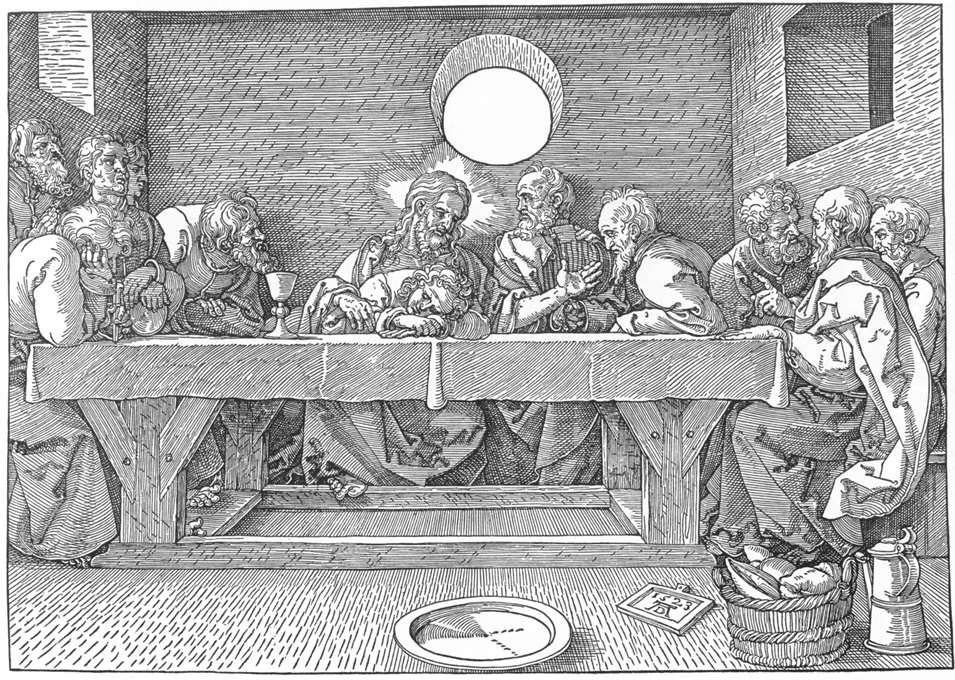Last Supper (Tintoretto) on:
[Wikipedia]
[Google]
[Amazon]
''The Last Supper'' is a painting by the Italian Renaissance artist
 Tintoretto depicted the
Tintoretto depicted the
Jacopo Tintoretto
Tintoretto ( , , ; born Jacopo Robusti; late September or early October 1518Bernari and de Vecchi 1970, p. 83.31 May 1594) was an Italian painter identified with the Venetian school. His contemporaries both admired and criticized the speed with ...
. An oil painting on canvas executed in 1592–1594, it is housed in the Basilica di San Giorgio Maggiore in Venice
Venice ( ; it, Venezia ; vec, Venesia or ) is a city in northeastern Italy and the capital of the Veneto Regions of Italy, region. It is built on a group of 118 small islands that are separated by canals and linked by over 400 ...
, Italy.
Overview
 Tintoretto depicted the
Tintoretto depicted the Last Supper
Image:The Last Supper - Leonardo Da Vinci - High Resolution 32x16.jpg, 400px, alt=''The Last Supper'' by Leonardo da Vinci - Clickable Image, Depictions of the Last Supper in Christian art have been undertaken by artistic masters for centuries, ...
several times during his artistic career. His earlier paintings for the Chiesa di San Marcuola (1547) and for the Chiesa di San Felice (1559) depict the scene from a frontal perspective, with the figures seated at a table placed parallel to the picture plane. This follows a convention observed in most paintings of the Last Supper, of which Leonardo da Vinci's late 1490s mural painting in Milan
Milan ( , , Lombard: ; it, Milano ) is a city in northern Italy, capital of Lombardy, and the second-most populous city proper in Italy after Rome. The city proper has a population of about 1.4 million, while its metropolitan city ...
, Italy
Italy ( it, Italia ), officially the Italian Republic, ) or the Republic of Italy, is a country in Southern Europe. It is located in the middle of the Mediterranean Sea, and its territory largely coincides with the homonymous geographical ...
, is probably the best-known example.
Tintoretto's painting of 1592–1594, a work of his final years, departs drastically from this compositional formula. The centre of the scene is occupied not by the apostles but instead by secondary characters, such as a woman carrying a dish and the servants taking the dishes from the table. The table at which the apostles sit recedes into space on a steep diagonal. Furthermore, Tintoretto's painting features a more personal use of light, which appears to come into obscurity from both the light on the ceiling and from Jesus' aureola
An aureola or aureole (diminutive of Latin ''aurea'', "golden") is the radiance of luminous cloud which, in paintings of sacred personages, surrounds the whole figure.
In Romance languages, the noun Aureola is usually more related to the d ...
. A host of angels
In various theistic religious traditions an angel is a supernatural spiritual being who serves God.
Abrahamic religions often depict angels as benevolent celestial intermediaries between God (or Heaven) and humanity. Other roles incl ...
hover above the scene.
Tintoretto's ''Last Supper'' makes use of Mannerist
Mannerism, which may also be known as Late Renaissance, is a style in European art that emerged in the later years of the Italian High Renaissance around 1520, spreading by about 1530 and lasting until about the end of the 16th century in Ita ...
devices in its complex and radically asymmetrical composition. In its dynamism and emphasis on the quotidian—the setting is similar to a Venetian inn—the painting points the way to the Baroque
The Baroque (, ; ) is a style of architecture, music, dance, painting, sculpture, poetry, and other arts that flourished in Europe from the early 17th century until the 1750s. In the territories of the Spanish and Portuguese empires including ...
. "The ability of this dramatic scene to engage viewers was well in keeping with Counter-Reformation
The Counter-Reformation (), also called the Catholic Reformation () or the Catholic Revival, was the period of Catholic resurgence that was initiated in response to the Protestant Reformation. It began with the Council of Trent (1545–1563) a ...
ideals and the Catholic Church's belief in the didactic nature of religious art."''Gardner's Art Through the Ages'', Volume II, 13th edition. p. 494.
References
Paintings by Tintoretto 1590s paintingsTintoretto
Tintoretto ( , , ; born Jacopo Robusti; late September or early October 1518Bernari and de Vecchi 1970, p. 83.31 May 1594) was an Italian painter identified with the Venetian school. His contemporaries both admired and criticized the speed wit ...
Paintings in Venice
Angels in art
Cats in art
Dogs in art
{{16C-painting-stub